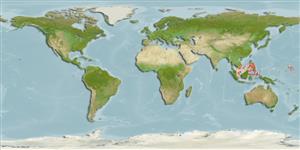>
Ovalentaria/misc (Various families in series Ovalentaria) >
Pomacentridae (Damselfishes) > Pomacentrinae
Etymology: Amphiprion: Greek, amphi = on both sides + Greek, prion, -onos = saw (Ref. 45335).
More on authors: Schultz & Welander.
Environment: milieu / climate zone / depth range / distribution range
Οικολογία
Θαλασσινό(ά) Υφαλόφιλο(α); μη μεταναστευτικό(ά); εύρος βάθους 3 - 40 m (Ref. 7247). Tropical; 25°C - ?; 15°N - 0°N
Western Pacific: Marshall Islands. Reported from New Caledonia (Ref. 9070).
Length at first maturity / Μέγεθος / Βάρος / Age
Maturity: Lm 7.5, range 7 - 8 cm
Max length : 12.0 cm TL αρσενικό/απροσδιόριστο; (Ref. 9710)
Short description
Κλείδες προσδιορισμού | Μορφολογία | Μορφομετρία
Ραχιαίες άκανθες (συνολικά) : 10 - 11; Μαλακές ραχιαίες ακτίνες (συνολικά) : 15 - 17; Εδρικές άκανθες: 2; Μαλακές εδρικές ακτίνες: 13 - 14. Black or orange with two vertical black-edged white bands, one behind the eye and one above the after. Black and orange color morphs believed to be dependent on which species of sea anemone the fish is associated with.
Oviparous, distinct pairing during breeding (Ref. 205). Eggs are demersal and adhere to the substrate (Ref. 205). Males guard and aerate the eggs (Ref. 205). Also Ref. 7471.
Allen, G.R., 1991. Damselfishes of the world. Mergus Publishers, Melle, Germany. 271 p. (Ref. 7247)
IUCN Red List Status (Ref. 130435: Version 2024-2)
Threat to humans
Harmless
Human uses
αλιεία: χωρίς ενδιαφέρον; Ενυδρείο: Εμπορικό(ά)
Εργαλεία
Special reports
Download XML
Διαδικτυακές πηγές
Estimates based on models
Preferred temperature (Ref.
123201): 27.7 - 29.1, mean 28.5 °C (based on 28 cells).
Phylogenetic diversity index (Ref.
82804): PD
50 = 0.5000 [Uniqueness, from 0.5 = low to 2.0 = high].
Bayesian length-weight: a=0.02570 (0.01622 - 0.04073), b=2.95 (2.81 - 3.09), in cm total length, based on LWR estimates for this species & (Sub)family-body (Ref.
93245).
Τροφικό Επίπεδο (Ref.
69278): 2.3 ±0.0 se; based on diet studies.
Generation time: 3.1 ( na - na) years. Estimated as median ln(3)/K based on 1
growth studies.
Ελαστικότητα (Ref.
120179): Μεσαίο(α), ελάχιστος χρόνος για διπλασιασμό πληθυσμού 1,4 - 4,4 έτη (K=0.3).
Fishing Vulnerability (Ref.
59153): Low to moderate vulnerability (31 of 100).
